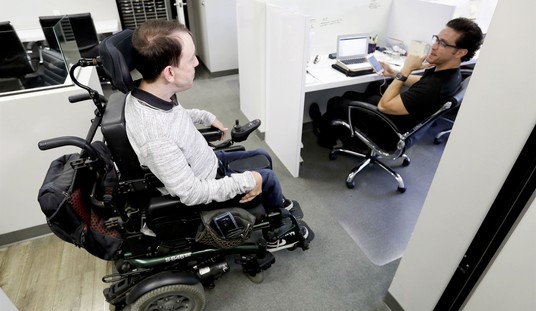
The quick-service restaurant (aka fast-food) industry is undergoing some cataclysmic changes.
On one hand, the Service Employees International Union and its hordes of astroturf allies are unleashing their four-year old scheme to unionize fast-food workers and drive up the wages of these workers to $15 an hour. Why?
Because, to the Marxist ideologues that run the SEIU and many of the groups that align themselves with the Purple People Eaters, market forces can be overridden by the demand that they are entitled to higher wages…and a union.
Not withstanding the fact that the fast-food industry has been traditionally populated by workers who are largely unskilled and, therefore, easily susceptible to being replaced, the SEIU and its cohorts believe that this is the future for today’s unions.
On the other hand, however, as has happened in other industries that have become heavily unionized (see esp. manufacturing), what seems more likely is that the consequences of the SEIU’s push for unionization and higher wages will lead to a faster and more efficient automated workforce of machines and, quite possibly, a better experience for the consumer.
Let’s look at this through the eyes (and experience) of the average fast-food customer of the future (named Bob), shall we?
Bob likes his burgers served piping hot. He likes them fast and he likes them cheap.
Almost overnight Bob has seen the fast-food industry transform itself from one manned by often slow and surly ne’er-do-wells to one that is highly efficient, consistently good, as well as affordable. How does that happen?
The Automated Order Takers
When Bob first arrives at his favorite fast-food joint–be it a sit down, take out or drive thru–he no longer be forced to wait by the “we’ll be right with you…” or “Welcome to _____________. Please wait…”
Nor, will Bob have to worry about to someone getting his order wrong.
Meet the perfect order taker:
“Welcome to McDonald’s. My name is HAL 9000. May I take your order?”
McDonalds recently went on a hiring binge in the U.S., adding 62,000 employees to its roster. The hiring picture doesn’t look quite so rosy for Europe, where the fast food chain is drafting 7,000 touch-screen kiosks to handle cashiering duties.
360 Burgers An Hour…Anyway You Like Them
After Bob’s burger order is taken by Hal, the automated order-taking Kiosk, his order his instantaneously transmitted to Alpha.
Alpha does everything a human burger flipper can do…except better, faster and (eventually) cheaper:
Our alpha machine frees up all of the hamburger line cooks in a restaurant.
It does everything employees can do except better:
- it slices toppings like tomatoes and pickles immediately before it places the slice onto your burger, giving you the freshest burger possible.
- our next revision will offer custom meat grinds for every single customer. Want a patty with 1/3 pork and 2/3 bison ground to order? No problem.
- Also, our next revision will use gourmet cooking techniques never before used in a fast food restaurant, giving the patty the perfect char but keeping in all the juices.
- it’s more consistent, more sanitary, and can produce ~360 hamburgers per hour.
Service Always Comes With A Smile
When Alpha is done cooking up Bob’s burger, someone has to deliver it, right? Not necessarily.
In China, robots are already serving diners:
After a dish is prepared, a robot waiter, which runs along tracks on the floor, carries it from kitchen to a table. Besides the robots on the ground, there are also two robots working in the air. Prepared dishes are placed on a suspended conveyor belt and when the plate reaches the right table the mechanical arms lift it off and set it down. As they eat, a singing robot entertains diners.
The Pay-Your-Check-Tablet
If Bob happens to be in a dine-in restaurant, after being served his Alpha-prepared food by the-robot-with-a-smile. Bob won’t even have to wait another 10-20 minutes for his busy waiter to bring him his check.
Instead, Bob can pay his bill whenever he wants, right at his table…with or without leaving a tip.
DineEquity (NYSE: DIN), franchisor of Applebee’s and IHOP® restaurants, announced the relationship with an aggressive schedule for 2014 installation throughout the Applebee’s system. The tablets, which enable guests to add to their orders, pay and play games from their seats, will also be considered for introduction at IHOP locations.
“Let’s face it, everyone who has ever been to a restaurant has been frustrated by waiting for their check,” said Applebee’s President Mike Archer. “Starting out, our goal was to create a way for guests to control when and how they pay their check. What we learned after nearly two years of testing is we can provide much more. The Presto tablet will deliver our guests a robust slate of offerings for not only transactions, but entertainment, social interaction and more, moving forward.” [h/t ZeroHedge]
While it is estimated that raising the minimum wage to $15 an hour (as the SEIU and its allies are demanding) would cost 460,000 fast-food jobs, the reality is, that may just be the tip of the iceberg.
If the SEIU succeeds in unionizing fast-food workers, the more time goes on, it will become more apparent that nearly everything fast-food workers do will eventually be performed by robots.
The fast-food industry, like so many unionized industries before it that have faced unrealistic union demands, will adapt its operating practices.
That, unfortunately, for the workers gullible enough to fall into the SEIU’s trap does not bode well for their jobs.
____________________________
“Truth isn’t mean. It’s truth.”
Andrew Breitbart (1969-2012)
Cross-posted on LaborUnionReport.com












Join the conversation as a VIP Member